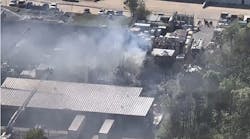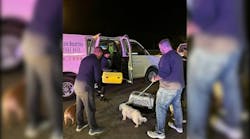When it comes to rapid egress or removing a downed firefighter, the most appropriate action to take due to conditions may be to use a window in the immediate area. A task such as this can be challenging if it is not trained on or practiced regularly. This article focuses on firefighter removal in a confined or restricted space. It is important to remember that the safest way to remove a downed firefighter from an upper level of a building is by using a staircase if at all feasible.
Firefighters may be forced to use windows for removal for a variety of reasons. The route taken into the structure may have been altered or changed during the course of operations by collapse, deteriorating fire conditions, the malfunction of a self-contained breathing apparatus (SCBA), an air-supply issue or disorientation. Factors such as surroundings, fire conditions, collapse or building construction can further increase the challenges that must be overcome.
An extreme and unfortunate example of this is cited in the 1992 line-of -duty death of Denver, CO, Fire Department Engineer Mark Langvardt. After he experienced trouble in the fire building, Langvardt made it to a second-floor window before being rendered unconscious. Due to structural collapse and intense fire conditions, other firefighters were unable to gain access to him through the interior of the building. Firefighters reached him by laddering and entering the second-story window. This window was 42 inches off the floor in a corridor that was only 28 inches wide due to storage shelves that were immovable; these are dimensions that make it difficult to maneuver and lift a downed firefighter.
Langvardt was eventually removed by an interior wall breach from an adjacent stairwell, but many unsuccessful attempts at removal were tried in a period estimated at 55 minutes by 15 or more firefighters. This incident has been the main catalyst for developing techniques devoted to rescuing downed firefighters within tight spaces and possessing elevated windowsills.
A constricted-space window removal requires at least three rescuers. These maneuvers are labor intensive and will require a rapid intervention team (RIT) to be operating on the exterior as well as the interior. Communication between these crews is of highest priority. The exterior RIT will need to know the specific equipment and exact location necessary to effect the rescue. This will normally take place after the initial RIT locates the downed firefighter.
Two of the most common ways to perform a removal of this nature are the "Denver" and "Fulcrum" techniques.
"Denver" Technique
To perform the "Denver" technique:
- One rescuer enters the window head first (photo 1) and crawls over the victim to the downed firefighter's feet. The rescuer then faces the victim and the window from which he entered.
- The rescuer then grasps the downed firefighter's SCBA shoulder straps and leans backward into a sitting position while also pulling the downed firefighter into a sitting position (photo 2). This will let the second rescuer enter the window in the area beneath the windowsill (photo 3). The second rescuer must be in a sitting position with his back against the wall (photo 4).
- The second rescuer raises his knees and places his feet at the victim's buttocks (photo 5), then grasps the downed firefighter's SCBA cylinder while the first rescuer straddles the victim's legs and positions the downed firefighter's arms onto the rescuer's upper legs.
- The first rescuer squats, wraps his arms around the downed firefighter and grabs the SCBA harness as close to the cylinder valve as possible (photo 5). The downed firefighter is then lifted onto the second rescuer's bent knees. The second rescuer then grabs and pushes upward in a bench-press motion against the cylinder to assist with the lift.
- After the downed firefighter is positioned on the second rescuer's knees, the first rescuer can squat again and place the victim's legs onto his shoulders. The first rescuer will place his face as deep into the groin area of the downed firefighter as possible. This is done to provide enough lift in one motion to raise the downed firefighter up and over the windowsill (photo 6). The first rescuer continues to drive toward the window and push upward while the second rescuer continues to push upward at the rear and lower portion of the SCBA cylinder (photo 7). These actions help to clear the downed firefighter's SCBA of the windowsill.
- The rescuers on the exterior, if positioned at ground level, should assist by reaching in and grasping the downed firefighter's shoulder straps to help lift and clear the downed firefighter's SCBA (photo 8).
If this maneuver is required to be performed from an upper-floor window, it is recommended that it take place with two rescuers on two ladders next to each other. This also reinforces the importance of the exterior firefighters being familiar and comfortable with performing removals down ladders.
"Fulcrum" Technique
The "Fulcrum" technique is limited to ground-floor or flat-surface conditions on which the exterior rescuers are based. This technique is not recommended when removing firefighters from an upper floor due to the amount of space that is required outside of the window as well as the stability of the area for exterior rescuers. The big advantage to this technique is that it can be useful in confined areas when only one rescuer may be able to enter the space around the window opening.
The "Fulcrum" technique can be applied to any ground-level window removal of a downed firefighter:
- The first rescuer enters the window head first. If the confined area allows, a second rescuer enters to assist the first.
- Once the first rescuer has positioned the downed firefighter, he applies a sling or loop of material to the downed firefighter (photo 9). Another option is to perform an SCBA harness conversion on the downed firefighter and grab from the SCBA shoulder straps if necessary.
- The first rescuer grabs the downed firefighter's SCBA shoulder straps and leans backward, moving the downed firefighter into a sitting position. This creates enough space for a backboard or ladder to be used as a fulcrum. One end is placed under the victim's buttocks while the other end rests on the windowsill.
- The rescuer on the interior places the victim on the board using the sling or SCBA harness conversion with help from the outside rescuers. To help accomplish this, the exterior rescuers can reach in and grab the sling or loop found at the head of the downed firefighter above the SCBA cylinder (photo 10) If the rescuers are using a SCBA harness conversion, they will grab the upper shoulder straps of the downed firefighter's SCBA. If the exterior rescuers are unable to reach them, an additional short piece of rope or webbing with a carabiner can be used to pull the downed firefighter onto the board or ladder.
- The victim is positioned on the board or ladder rotated slightly to one side due to the SCBA. The exterior rescuers hold the sling or SCBA shoulder straps with tension. The interior rescuers raise the bottom of the board or ladder until it is parallel with the floor. The exterior rescuers apply pressure to the board in a downward motion to assist in raising the downed firefighter and board (photo 11). It will also be the responsibility of the exterior rescuers to maintain the firefighter's position on the board or ladder and prevent him from sliding off as the board or ladder is moved through the window (photo 12).
- The exterior RIT grabs each side of the board or ladder as it exits the window (photo 13). Once clear of the window, the downed firefighter can be treated by EMS personnel.
Conclusion
It is important for firefighters to remember that the "Denver" and "Fulcrum" techniques can be applied to all situations involving window exits and any other types of openings, not only those with confined or restricted spaces. Today's fireground hazards and limited staffing make the challenge of our jobs increasingly harder each day. Rescuing one of our own in a situation that requires a removal through a window will require us to be at our best. Are you and your crew prepared to meet the challenge?
JEFFREY PINDELSKI, a Firehouse.com contributing editor, is a 20-year veteran of the fire service and deputy chief of operations with the Downers Grove, IL, Fire Department. He is a staff instructor at the College of Du Page and has been involved with the design of several training programs dedicated to firefighter safety and survival. Pindelski is a co-author of the text Rapid Intervention Company Operations and a revising author of the Firefighter's Handbook, third edition. He may be contacted at [email protected].
Download the PDF's below to view this article's images.





